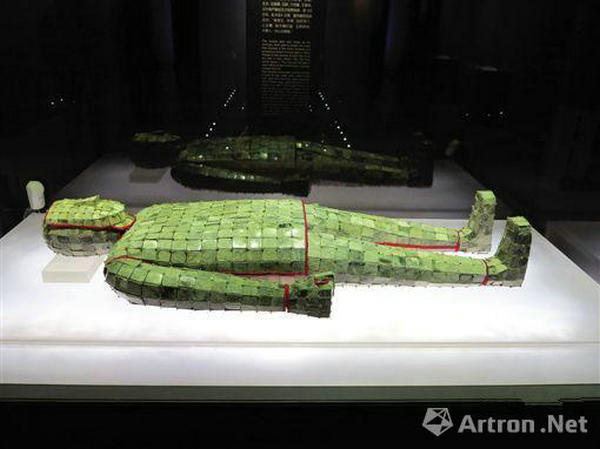| Home > China Feature |
Jade and Gold Clothes of a Prince's Wife
An exhibition featuring gold and silver wares, jade wares and weapons unearthed from tombs of the Western Han Dynasty (206 BC- 220AD) launched in Changsha in Hunan province today.

Among the showpieces, the jade and gold clothes of Dou Wan, the wife of Prince Jin of Zhongshan, attracted much attention. With 2,160 jade pieces held together by 700g of gold wire, the 1.72m long clothing is a rare national cultural relic.
Also called yuxia, gold-woven clothes were the finest garb for dead emperors and high ranking nobles in the Han Dynasty.
A complete suit consists of six parts: a head covering, upper clothes, sleeves, gloves, trousers and shoes. Each part was made by various shapes of jade pieces. On the jade pieces, there are many small holes, through which the pieces can be "woven" into a suit or clothing using fine gold, silver or bronze wire.
Evolution of jade and gold clothes
The clothes were developed from jade decorations that covered the faces of the dead. These jade pieces made in the shape of eyebrows, noses, mouths and eyes were sewed onto cloth. The earliest jade face decorations were excavated from a tomb dating to the late Western Zhou Dynasty (c.11th century-771 BC).
By the Warring States Period (475-221 BC), the decorations had become very popular. Emperors and nobles often had jade face decorations as funeral objects.
In the early period of the Han Dynasty, the jade decorations extended to the areas of the head, hands and feet. The change prepared for the coming of a full body suit of made of jade and gold.
Later, with the formation of the Silk Road, large quantities of hetian jade came to China and provided enough material for emperors and nobles to cover their whole bodies when they died. The most beautiful and earliest jade and gold clothes unearthed in a tomb in Xuzhou in Jiangsu province were made of 4,248 pieces of white hetian jade and 1,600g of gold wire.
Happy posthumous life
Jade and gold clothes were thought to prevent a dead body from decaying. Moreover, people in the Han Dynasty believed in the immortality of the soul. In their mind, as long as the soul was protected well, dead people could still enjoy their posthumous lives as much as when they were alive.
Since the soul can only exist with the body, the emperors and nobles in the Han Dynasty endeavored to find ways to keep the body unchanged when they passed away. They believed that jade and gold are two essences of nature, which have magical functions to protect the human body.
To keep the soul in the body, they also intended to use jade to block the nine holes on the human body: eyes, ears, nostrils, mouth, sexual organs and anus.
Tel: 0086-571-88165697
Email:eduunion@cuecc.com
Skype:studycn001
QQ:2853662503
Art
 more
moreChina Beijing International Diet ...
Recently, The hit CCTV documentary, A Bite of China, shown at 10:40 ...

Exhibition of Ancient Chinese Jad...
At least 8,000 years ago, Chinese ancestors discovered a beautiful...

Longmen Grottoes
The Longmen Grottoes, located near Luoyang, Henan Province, are a tr...

Custom
 more
moreWeb Dictionary
Martial Arts
Celebriting 70 years' efforts in restoring Mogao...
Work is being carried out at the restoration site of cave No 98 a...
Hong Kong Children's Symphony performs in Seattle
Under the theme of Tribute to the Golden Age, a concert featuring a ...
Beijing plan to hold Sand Sculpture Festival
The Beijing Sand Sculpture Festival is in the last phase of prepar...





 print
print  email
email  Favorite
Favorite  Transtlate
Transtlate 








